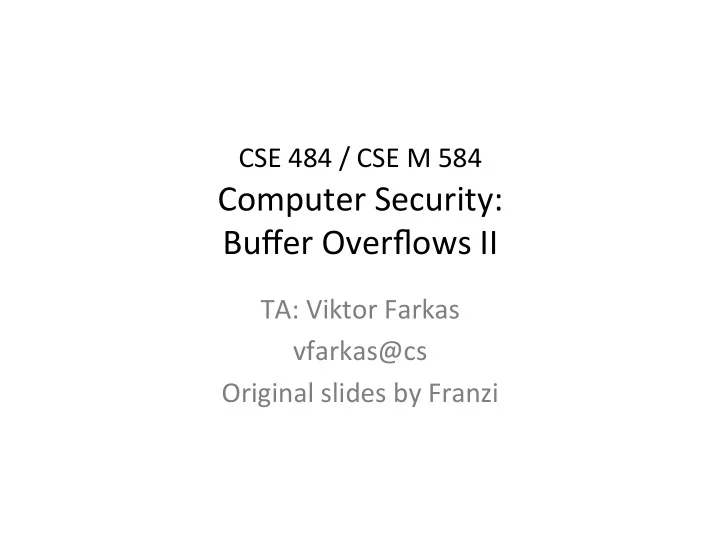

CSE ¡484 ¡/ ¡CSE ¡M ¡584 ¡ Computer ¡Security: ¡ Buffer ¡Overflows ¡II ¡ TA: ¡Viktor ¡Farkas ¡ vfarkas@cs ¡ Original ¡slides ¡by ¡Franzi ¡
Lab ¡1 ¡Deadline ¡Reminders ¡ • Lab ¡1 ¡Checkpoint ¡ (Sploits ¡1-‑3) ¡due ¡April ¡18th ¡at ¡ 8pm ! ¡ – Turn ¡in ¡text ¡file ¡of ¡md5sums ¡for ¡sploits ¡1-‑3 ¡ 8a4d47b908dc53f760e8�fa51b02bd440 ¡ ¡sploit1.c ¡ 545879cf5523e93be9a6�93111ee967e8 ¡ ¡sploit2.c ¡ 1cea0ba2bb9b5bb0fafe�448a8a7bf0df ¡ ¡sploit3.c ¡ • Lab ¡1 ¡Final ¡due ¡in ¡two ¡weeks ¡(April ¡29th, ¡8pm). ¡ • If ¡you ¡don’t ¡have ¡a ¡group ¡or ¡access ¡yet, ¡talk ¡to ¡me ¡ today! ¡ • Upcoming ¡office ¡hours: ¡ – Tomorrow ¡(Friday) ¡Thomas ¡and ¡Kevin ¡-‑ ¡2:00-‑3:00pm, ¡ CSE ¡021 ¡
Lab ¡1 ¡Notes/Hints ¡ • If ¡you ¡get ¡stuck, ¡move ¡on! ¡ • Don’t ¡procrasenate ¡on ¡Sploits ¡4-‑7. ¡Some ¡of ¡them ¡ are ¡much ¡harder. ¡ • Sploit ¡3: ¡No ¡frame ¡pointer, ¡so ¡you ¡can ¡only ¡ change ¡last ¡byte ¡of ¡saved ¡EIP. ¡Think ¡about ¡an ¡ exiseng ¡instruceon ¡you ¡could ¡point ¡to ¡that ¡would ¡ have ¡desirable ¡side ¡effects. ¡ • You ¡have ¡more ¡than ¡one ¡copy ¡of ¡your ¡buffer: ¡(1) ¡ as ¡argument ¡to ¡funceon, ¡(2) ¡where ¡it ¡gets ¡copied. ¡ • Sploit ¡4 ¡is ¡not ¡necessarily ¡harder ¡than ¡Sploit ¡3. ¡
Sploit ¡5 ¡Tips ¡ • Buffer ¡copied ¡to ¡the ¡heap. ¡ • Target ¡5 ¡uses ¡the ¡implementaeon ¡that’s ¡found ¡ in ¡ ~/sources/tmalloc.c . ¡ • Read ¡“Once ¡upon ¡a ¡free()”: ¡ hjp://www.phrack.org/issues.html? issue=57&id=9&mode=txt ¡ ¡ ¡
Dynamic ¡Memory ¡Management ¡in ¡C ¡ • Memory ¡allocaeon: ¡malloc(size_t ¡n) ¡ – Allocates ¡n ¡bytes ¡and ¡returns ¡a ¡pointer ¡to ¡the ¡ allocated ¡memory; ¡memory ¡not ¡cleared. ¡ • Memory ¡deallocaeon: ¡free(void ¡* ¡p) ¡ – Frees ¡the ¡memory ¡space ¡pointed ¡to ¡by ¡p, ¡which ¡ must ¡have ¡been ¡returned ¡by ¡a ¡previous ¡call ¡to ¡ malloc() ¡(or ¡similar). ¡ – If ¡free(p) ¡has ¡been ¡called ¡before ¡(“double ¡free”), ¡ undefined ¡behavior ¡occurs. ¡ – If ¡p ¡is ¡null, ¡no ¡operaeon ¡is ¡performed. ¡ (Some ¡memory ¡management ¡slides ¡adapted ¡from ¡Vitaly ¡Shmaekov) ¡
Target5: ¡What’s ¡the ¡problem? ¡ char *p; char *q; if ( (p = tmalloc(160)) == NULL) { exit(EXIT_FAILURE); } p ¡(160) ¡ if ( (q = tmalloc(160)) == NULL) {exit(EXIT_FAILURE); } p ¡(320) ¡ tfree(p); tfree(q); q ¡(160) ¡ if ( (p = tmalloc(320)) == NULL) {exit(EXIT_FAILURE); } obsd_strlcpy(p, arg, 320); “Undefined” ¡behavior ¡ ¡ ¡ tfree(q); on ¡second ¡free() ¡
Free ¡Chunks ¡ (as ¡used ¡in ¡tmalloc.c) ¡ • Chunks ¡organized ¡into ¡doubly-‑linked ¡list. ¡ • Each ¡chunk ¡on ¡list ¡contains ¡forward/back ¡pointers ¡to ¡ next/previous ¡chunks ¡in ¡the ¡list. ¡ – LSB ¡of ¡right ¡pointer ¡contains ¡free ¡bit. ¡ – Adjacent ¡free ¡chunks ¡are ¡consolidated. ¡ ¡ Previous ¡pointer ¡ Previous ¡pointer ¡ Next ¡pointer ¡ 0 Next ¡pointer ¡ 1 User ¡Data ¡ Unused ¡space ¡(not ¡cleared) ¡ Allocated ¡Chunk ¡ Free ¡Chunk ¡
Chunk ¡Maintenance ¡ One ¡big ¡ ¡ free ¡chunk: ¡ Split ¡to ¡malloc: ¡ Split ¡to ¡malloc ¡ (twice): ¡ Free ¡(twice): ¡ Consolidate ¡ ¡ free ¡chunks: ¡
Chunks ¡in ¡tmalloc.c ¡ • Lines ¡20-‑28 ¡give ¡chunk ¡structure: ¡ ¡ Ptr ¡to ¡Leu ¡ Ptr ¡to ¡Right ¡ Data ¡ • Look ¡at ¡chunk ¡consolidaeon ¡in ¡ tfree(p) : ¡ Hey ¡look, ¡if ¡we ¡control ¡ ¡ ¡ q = p->s.l; chunks ¡p ¡(and ¡q), ¡this ¡code ¡ … will ¡write ¡the ¡value ¡of ¡q ¡ q->s.r = p->s.r; (address ¡of ¡buffer?) ¡to ¡a ¡ locaeon ¡we ¡specify ¡ p->s.r->s.l = q; (locaeon ¡of ¡saved ¡EIP?). ¡ • Goal: ¡populate ¡(fake) ¡chunks ¡appropriately. ¡
Format ¡string ¡Vulnerability ¡(6) ¡ Credit: ¡hjp://www.cis.syr.edu/~wedu/Teaching/cis643/LectureNotes_New/Format_String.pdf ¡
General ¡Queseons? ¡
Recommend
More recommend